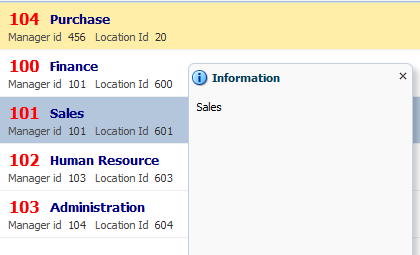Sometimes we need to create and add ADF Faces components at runtime , we can do it programmatically
I have posted about this before
Creating dynamic layout (form and UI Component) using ADF Faces
Now this post talks about getting value from programmatically created component, means when user enters value in those component then how to access that value in managed bean
Here i am using Jdev 12.1.3 , Let's see the implementation part
Created a page and added two buttons , one to create component at run time and second one to get values from those components
See page XML source code -
To create components at run time i have used same approach described in above blog post
Check the code written on Create Components button
Now run application and click on button , you will see two inputText are created
Now to get value of these components follow the steps
1. Get Parent layout
2. Iterate over parent to get all child components
3. Get Value of every child
See the code written on get value button in managed bean
Again check , enter value in both inputText and click on button to get value
Output on console-
Sample ADF Application- Download
Cheers :) Happy Learning
I have posted about this before
Creating dynamic layout (form and UI Component) using ADF Faces
Now this post talks about getting value from programmatically created component, means when user enters value in those component then how to access that value in managed bean
Here i am using Jdev 12.1.3 , Let's see the implementation part
Created a page and added two buttons , one to create component at run time and second one to get values from those components
See page XML source code -
<af:document title="ProgComponent.jspx" id="d1"> <af:form id="f1"> <af:spacer width="10" height="10" id="s3"/> <af:button text="Create Components " id="b1" actionListener="#{viewScope.GetValueProgCompBean.createComponentsAction}"/> <af:spacer width="10" height="10" id="s1"/> <af:button text="Get Value" id="b2" actionListener="#{viewScope.GetValueProgCompBean.getValueOfCompAction}"/> <af:panelGroupLayout id="pgl1" layout="vertical" binding="#{viewScope.GetValueProgCompBean.parentGroupBind}"> <af:spacer width="10" height="10" id="s2"/> </af:panelGroupLayout> </af:form> </af:document>
To create components at run time i have used same approach described in above blog post
Check the code written on Create Components button
import javax.faces.component.UIComponent; import javax.faces.event.ActionEvent; import oracle.adf.view.rich.component.rich.input.RichInputText; import oracle.adf.view.rich.component.rich.layout.RichPanelGroupLayout; import oracle.adf.view.rich.context.AdfFacesContext;
//Binding of panel group layout , it will be parent of prog. created components private RichPanelGroupLayout parentGroupBind; public void setParentGroupBind(RichPanelGroupLayout parentGroupBind) { this.parentGroupBind = parentGroupBind; } public RichPanelGroupLayout getParentGroupBind() { return parentGroupBind; } /**Method to add child components to parent * @param parentUIComponent * @param childUIComponent */ public void addComponent(UIComponent parentUIComponent, UIComponent childUIComponent) { parentUIComponent.getChildren().add(childUIComponent); AdfFacesContext.getCurrentInstance().addPartialTarget(parentUIComponent); } /**Method to create Input text at run time * @param actionEvent */ public void createComponentsAction(ActionEvent actionEvent) { //Create an Object of desired UI Component RichInputText ui = new RichInputText(); //Set properties ui.setId("rit1"); ui.setLabel("Input text 1"); ui.setContentStyle("font-weight:bold;color:red"); //Now add this component to any parent component addComponent(getParentGroupBind(), ui); RichInputText ui1 = new RichInputText(); ui1.setId("rit2"); ui1.setLabel("Input text 2"); ui1.setContentStyle("font-weight:bold;color:red"); addComponent(getParentGroupBind(), ui1); }
Now run application and click on button , you will see two inputText are created
Now to get value of these components follow the steps
1. Get Parent layout
2. Iterate over parent to get all child components
3. Get Value of every child
See the code written on get value button in managed bean
/**Method to Iterate over parent and get value of all child components * @param actionEvent */ public void getValueOfCompAction(ActionEvent actionEvent) { RichPanelGroupLayout PF = getParentGroupBind(); // Get Parent Layout List<UIComponent> listcomp = PF.getChildren(); // Get all child Iterator iter = listcomp.iterator(); // Create an Iteraotr to iterate over childs while (iter.hasNext()) { UIComponent comp = (UIComponent) iter.next(); // Get next Child Component System.out.println("Component is-" + comp + " and value is-" + comp.getAttributes().get("value")); //Get Component detial and it's value } }
Again check , enter value in both inputText and click on button to get value
Output on console-
Sample ADF Application- Download
Cheers :) Happy Learning
























